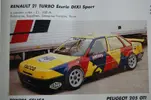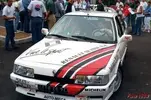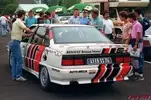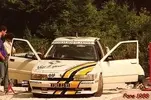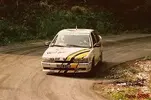There is more to life with TurboRenault.co.uk
You are using an out of date browser. It may not display this or other websites correctly.
You should upgrade or use an alternative browser.
You should upgrade or use an alternative browser.
todays finds
- Thread starter lyn21turbo
- Start date
lyn21turbo
Active Member

its for sale in Belgium
Te koop 20/09
wegens stopzetting hobby:
startnummer 325 in S3 NVACT (1ste plaats in kampioenschap)
Renault 21 2 l turbo
- geprepareerde 2 l turbo motor gereviseerd begin seizoen 2006
- aangepaste versnellingsbak (UN1) met sperdifferentieel
- op maat gemaakte aluminium intercooler
- aangepaste software rekeneenheid
- proflex vering (deze zomer nog nagekeken door MR Motorsport)
- zeer snel, betrouwbaar en sterke ophanging
Verkrijgbaar met eventuele wisselstukken: reservemotoren, turbo's, 2 x reservecarosserie R21 turbo, cardans, versnellingsbakken, wielen met diverse crossbanden en zeer veel andere onderdelen.
Beschikbaar na laatste cross NVACT 22/10/2006
Vraagprijs voor auto met alle wisselstukken: 6800 euro.
Ook verkrijgbaar zonder reservemotoren en turbo's.
Indien interesse doe maar een bod !!
e-mail: [email protected]
tel.: 0496 55 39 83
lyn21turbo
Active Member
loook what renaults hiding
seems they have a grpN?
ice racer
3 supertourisme
2 superproduction
2 europacups
several std cars and even the american versions








seems they have a grpN?
ice racer
3 supertourisme
2 superproduction
2 europacups
several std cars and even the american versions








Last edited by a moderator:
Mattfletcher
Active Member
That looks like a well equipped garage, nicely stacked with racers. Any chance we could get a big car transporter together and have a night out. Im sure I could find somewhere to hide a couple of those babies.
lyn21turbo
Active Member
http://www.bellapix.com/user/global/ACCOUNTS/USER3fbb55d6f08a1/images/42ac5a4e36446.jpg
Twingo, moteur R21 turbo
Twingo, moteur R21 turbo
lyn21turbo
Active Member
nice little write up about grpN
http://www.rallye-info.com/carspecs.asp?car=270
First event: Tour de Corse 1988.
Renault R21 Turbo General Information
The Renault R21 came at a time when many things changed in Renault's car design. The R21 was a clear cut, straight, no nonsense design, it was a modern and functional saloon and it's ride would earn the highest ratings even today. Indeed the R21 is definitely one of the most underrated cars there ever was. Such superb was its ride and comfort that, believe it or not, its successor, the Renault Laguna, could hardly better the R21 - and the Laguna is absolutely reknown for its fantastic ride! But more so, the R21 Turbo was the first turbo charged Renault with an OHC camshaft layout - yes, all the incredible R5 versions were UHC! More, Renault was one of the first brands to market FWD, yet they regularly featured longitudinal engines, a strange layout combined with FWD it seems nowadays. The R21 came right at the time this was to change and as a result the R21 is probably the only car ever designed that was available with longitudinal as well as transverse engines - the R5 changed to transverse engines following a face lift, but with the R21 the diesels and the 2.2 petrol were longitudinal, all other engines transverse in one and the same model and year of car!
But coming to rally terms, the R21 was indeed made in a version called R21 Turbo Quadra - a turbo 4x4. This however was a limited edition road car with production numbers too small for group A & group N homologation, such a serious return of Renault to the WRC was eliminated by the rules. Funny enough this fate Renault shared with Peugeot: The R21 Turbo Quadra and the Peugeot 405 T16 where both turbo 4x4 cars limited to 400 units, which would have been sufficient for group 4, but not for the post 1987 regs. And both these brands were full of criticism when the FIA changed the WRC from group B to group A. Both Renault and Peugeot now claimed they created these cars as homologation specials and would return to the WRC if it wasn't for the required 5000 units per annum! Only the FWD version of the R21 Turbo was produced in sufficient numbers and with FWD there seemed to be not much point in a powerful group A version - again a similar fate to Peugeot, where only the non-turbo 405 MI16x4 was made in sufficient numbers for modern homologation.
The group N version of the R21 Turbo however was superb and famous, it only had one problem: it stayed in the shadow of the group N R5 GT Turbo! Nevertheless, compared to the R5 GT Turbo the R21 Turbo had a 2.0 engine that "only" produced 175BHP but an amazing 270NM torque. Bozian actually had an R21 Turbo up to 245BHP, which only shows what could have been possible with some group A development. However a group A project was never suported, so the car was officially never more than group N. The torque could easily make up for weight and size and made the R21 a serious contender in the faster and more flowing stages. The car came to major fame in French regional events with drivers as Michel Rats and Philippe Bugalski. Bugalski also took the car to WRC events, but he failed to prove the car's potential, twice he had to withdraw following road accidents!
One of the most interesting driver pairings in the WRC ever was on this occasion: Rallye Monte Carlo 1990, #0 course opening car, R21 Turbo, driver Jean Alesi, navigator Jean-Marie Ballestre.
http://www.rallye-info.com/carspecs.asp?car=270
First event: Tour de Corse 1988.
Renault R21 Turbo General Information
The Renault R21 came at a time when many things changed in Renault's car design. The R21 was a clear cut, straight, no nonsense design, it was a modern and functional saloon and it's ride would earn the highest ratings even today. Indeed the R21 is definitely one of the most underrated cars there ever was. Such superb was its ride and comfort that, believe it or not, its successor, the Renault Laguna, could hardly better the R21 - and the Laguna is absolutely reknown for its fantastic ride! But more so, the R21 Turbo was the first turbo charged Renault with an OHC camshaft layout - yes, all the incredible R5 versions were UHC! More, Renault was one of the first brands to market FWD, yet they regularly featured longitudinal engines, a strange layout combined with FWD it seems nowadays. The R21 came right at the time this was to change and as a result the R21 is probably the only car ever designed that was available with longitudinal as well as transverse engines - the R5 changed to transverse engines following a face lift, but with the R21 the diesels and the 2.2 petrol were longitudinal, all other engines transverse in one and the same model and year of car!
But coming to rally terms, the R21 was indeed made in a version called R21 Turbo Quadra - a turbo 4x4. This however was a limited edition road car with production numbers too small for group A & group N homologation, such a serious return of Renault to the WRC was eliminated by the rules. Funny enough this fate Renault shared with Peugeot: The R21 Turbo Quadra and the Peugeot 405 T16 where both turbo 4x4 cars limited to 400 units, which would have been sufficient for group 4, but not for the post 1987 regs. And both these brands were full of criticism when the FIA changed the WRC from group B to group A. Both Renault and Peugeot now claimed they created these cars as homologation specials and would return to the WRC if it wasn't for the required 5000 units per annum! Only the FWD version of the R21 Turbo was produced in sufficient numbers and with FWD there seemed to be not much point in a powerful group A version - again a similar fate to Peugeot, where only the non-turbo 405 MI16x4 was made in sufficient numbers for modern homologation.
The group N version of the R21 Turbo however was superb and famous, it only had one problem: it stayed in the shadow of the group N R5 GT Turbo! Nevertheless, compared to the R5 GT Turbo the R21 Turbo had a 2.0 engine that "only" produced 175BHP but an amazing 270NM torque. Bozian actually had an R21 Turbo up to 245BHP, which only shows what could have been possible with some group A development. However a group A project was never suported, so the car was officially never more than group N. The torque could easily make up for weight and size and made the R21 a serious contender in the faster and more flowing stages. The car came to major fame in French regional events with drivers as Michel Rats and Philippe Bugalski. Bugalski also took the car to WRC events, but he failed to prove the car's potential, twice he had to withdraw following road accidents!
One of the most interesting driver pairings in the WRC ever was on this occasion: Rallye Monte Carlo 1990, #0 course opening car, R21 Turbo, driver Jean Alesi, navigator Jean-Marie Ballestre.
lyn21turbo
Active Member
couple of quick glimpses of the europacup in spain
http://video.google.com/videoplay?docid=2433981802326250956
http://video.google.com/videoplay?docid=2433981802326250956
lyn21turbo
Active Member
DaveL485
Staff member
you seen that car IRL Dave, in Lachatre, it now red/grey.
Yep. Liked the wheels on it then too!
lyn21turbo
Active Member
several times i have read various forums that a 21t took part in the dakar rallies in africa,, and it usualy stems from this pic

but everyone always says that that car is from rally raid or more likely from the spanish or portugese Baja rallies
ragnotti apprently also drove an XCOM prototype with r21t mechanical components,
but anyway ive just found this,, 2 guys from renault Mans, and sponsored by Mans Competition, its a custom 21t pick up, which took part over 2 years,, its 1st year 1988 only ended up going as far as Algeria and the second year 1989 it ran out of funding
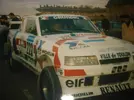

but everyone always says that that car is from rally raid or more likely from the spanish or portugese Baja rallies
ragnotti apprently also drove an XCOM prototype with r21t mechanical components,
but anyway ive just found this,, 2 guys from renault Mans, and sponsored by Mans Competition, its a custom 21t pick up, which took part over 2 years,, its 1st year 1988 only ended up going as far as Algeria and the second year 1989 it ran out of funding

Last edited by a moderator:
Lee_R21Turbo
Active Member
Haha....thats mental!!!
Love it - next project perhaps!!!
I really dont know where you find all this ****! lol
Love it - next project perhaps!!!
I really dont know where you find all this ****! lol
roddy21t
Well-Known Member
lyn21turbo
Active Member
its just random **** i find lol
lyn21turbo
Active Member
europacup on track in france recently
http://dailymotion.alice.it/video/x5kdrs_360-coupe-de-france-des-circuits-r_auto
http://dailymotion.alice.it/video/x5kdrs_360-coupe-de-france-des-circuits-r_auto
lyn21turbo
Active Member
Similar threads
- Replies
- 0
- Views
- 41







